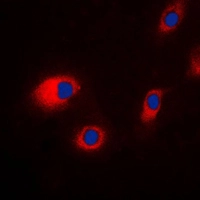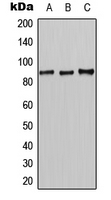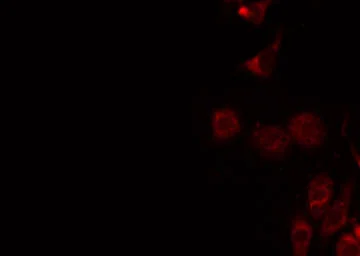
ICC/IF analysis of formalin-fixed HeLa cells using GTX55139 CLCN7 antibody. Red : Primary antibody Blue : DAPI Permeabilization : 0.1% Triton X-100 in TBS for 5-10 minutes
CLCN7 antibody
GTX55139
ApplicationsImmunoFluorescence, Western Blot, ImmunoCytoChemistry
Product group Antibodies
TargetCLCN7
Overview
- SupplierGeneTex
- Product NameCLCN7 antibody
- Delivery Days Customer9
- Application Supplier NoteWB: 1:500 - 1:1000. ICC/IF: 1:100 - 1:500. *Optimal dilutions/concentrations should be determined by the researcher.Not tested in other applications.
- ApplicationsImmunoFluorescence, Western Blot, ImmunoCytoChemistry
- CertificationResearch Use Only
- ClonalityPolyclonal
- ConjugateUnconjugated
- Gene ID1186
- Target nameCLCN7
- Target descriptionchloride voltage-gated channel 7
- Target synonymschloride channel 7 alpha subunit; chloride channel protein 7; chloride channel, voltage-sensitive 7; CLC7; CLC-7; H(+)/Cl(-) exchange transporter 7; HOD; OPTA2; OPTB4; PPP1R63; protein phosphatase 1, regulatory subunit 63
- HostRabbit
- IsotypeIgG
- Protein IDP51798
- Protein NameH(+)/Cl(-) exchange transporter 7
- Scientific DescriptionThe product of this gene belongs to the CLC chloride channel family of proteins. Chloride channels play important roles in the plasma membrane and in intracellular organelles. This gene encodes chloride channel 7. Defects in this gene are the cause of osteopetrosis autosomal recessive type 4 (OPTB4), also called infantile malignant osteopetrosis type 2 as well as the cause of autosomal dominant osteopetrosis type 2 (OPTA2), also called autosomal dominant Albers-Schonberg disease or marble disease autosoml dominant. Osteopetrosis is a rare genetic disease characterized by abnormally dense bone, due to defective resorption of immature bone. OPTA2 is the most common form of osteopetrosis, occurring in adolescence or adulthood. [provided by RefSeq, Jul 2008]
- Storage Instruction-20°C or -80°C,2°C to 8°C
- UNSPSC12352203
References
- H(+)/Cl(-) exchange transporter 7 promotes lysosomal acidification-mediated autophagy in mouse cardiomyocytes. Lin J et al., 2021 Mar, Mol Med RepRead more








